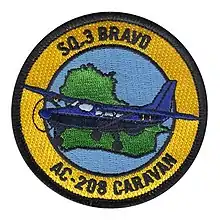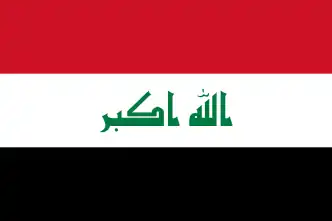3rd Squadron (Iraq)
The 3rd Attack and Reconnaissance Squadron is a squadron of the Iraqi Air Force.
| 3rd Squadron, Iraqi Air Force | |
|---|---|
 Official 3rd Squadron patch | |
| Active | 1934-1942 1948-2003 2004-present |
| Country | Iraq |
| Branch | Iraqi Air Force |
| Role | Attack Reconnaissance |
| Base | Ali Air Base[1] Balad Air Base[1] |
| Insignia | |
| Fin Flash |  |
| Aircraft flown | |
| Attack | Cessna AC-208B |
| Reconnaissance | Cessna RC-208B |
| Trainer | Cessna TC-208B |
Pre-2003 era
No. 3 Squadron was first established in October 1934, operating Hawker Audax fighter/army cooperation aircraft from Rasheed Air Base in Baghdad.[2][3] The squadron participated in its first combat operations during the 1935-1936 Iraqi Shia revolts, and lost one of its aircraft to machine-gun fire.[4] At the time of the Anglo-Iraqi War, No. 3 Squadron was based in Mosul, but it did not fly any combat sorties during the war.[5] However, in March 1942, Rasheed Air Base was suddenly flooded, and the squadron's remaining aircraft were destroyed. No. 3 Squadron was thus disbanded.[6]
No. 3 Squadron was reestablished in early 1948, flying de Havilland Doves.[7] In the 1950s, it also received three Bristol Freighters.[8] In 1951, No. 3 Squadron received Iraq's first helicopters, three Westland Dragonflies.[9] Later, the unit specialised in heavy and VIP transport: as of 1958, it was Doves, Freighters and de Havilland Herons from Rasheed Air Base.[10] In the early 1960s, No. 3 Squadron received six Antonov An-12BPs.[11] These were transferred to the newly created No. 23 Squadron in 1965.[12] That same year, the squadron started operating Mil Mi-4s.[13] On 5 June 1967, one of No. 3 Squadron's Doves was destroyed on the ground during an Israeli airstrike on H-3 Air Base.[14]
As of October 1973, No. 3 Squadron was based at Muthenna Air Base, and flew two Doves, two Herons, and two Tupolev Tu-124s. Despite its specialisation in VIP transport,[15] during the October War the squadron participated in the Iraqi air bridge to Egypt and Syria with its Herons and Tu-124s.[16] As of September 1980, No. 3 Squadron operated Lockheed JetStars and Dassault Falcon 20s from Muthenna.[17]
In 2002 the squadron was reported as flying An-24s and An-26s, but from Al-Bakr Air Base.[18]
Post-2003 era

The 3rd Squadron was recreated in 2004, and received six Comp Air 7SLs donated by the United Arab Emirates, starting in November 2004. These aircraft were equipped with a reconnaissance sensor suite. A month later, it started receiving Bell 206 helicopters.[19] These were based at New Al Muthana Air Base. Subsequently, they were passed on to the Iraqi Army Aviation Corps.[20] In April 2005, the squadron was declared operational. On 30 May, one of the 3rd Squadron's Comp Air 7SLs was the first aircraft lost by the post-2003 Iraqi Air Force, when it crashed near Jalawla. One Iraqi pilot and four American servicemen died in the crash. As a result, the whole fleet was grounded in January 2006. All of the Iraqi Comp Air 7SLs were withdrawn in late 2007.[19] Meanwhile, in 2005-2006 the 3rd Squadron received four SAMA CH2000s at Kirkuk Air Base for reconnaissance and training tasks.[21]

Starting in 2008, the 3rd Squadron received Cessna 208s in three different variants: the TC-208B for training, the RC-208B for ISR, and the AC-208B counterinsurgency attack aircraft.[22] With the arrival of the Cessna 208s, the CH2000s were transferred to the 70th Squadron.[21] After the delivery of the first AC-208Bs, the 3rd Squadron was renamed the 3rd Attack and Reconnaissance Squadron. The squadron's AC-208s were heavily used, including during combat operations: by the end of July 2015, they had launched more than 1,600 AGM-114 Hellfire missiles.[22] On 16 March 2016, an AC-208B crashed near Hawija, killing its three crew members. Islamic State militants claimed they shot it down using a 57 mm anti-aircraft gun.[23]
References
Notes
- Delalande 2016, p. 71
- Pesach Malovany, "Wars of Modern Babylon", University Press of Kentucky, June 2017, ISBN 0813169437 / ISBN 978-0813169439, fn. 2, p.813.
- Sipos & Cooper 2020, p. 16
- Sipos & Cooper 2020, p. 16
- Sipos & Cooper 2020, p. 28
- Sipos & Cooper 2020, p. 33
- Sipos & Cooper 2020, p. 34
- Sipos & Cooper 2020, p. 35
- Sipos & Cooper 2020, p. 39
- Sipos & Cooper 2020, p. 45
- Sipos & Cooper 2020, p. VII
- Sipos & Cooper 2020, p. 59
- Sipos & Cooper 2020, p. 57
- Sipos & Cooper 2020, p. 69
- Sipos & Cooper 2022, p. 8
- Sipos & Cooper 2022, p. 19
- Sipos & Cooper 2022, p. 52
- "Appendix 2 (Air Order of Battle) to Annex B (Intelligence) to LOGCAP Contingency Support Plan" (PDF). White House FOIA/Army Materiel Command. 7 December 2002.
- Delalande 2016, p. 27
- Delalande 2016, p. 54
- Delalande 2016, p. 28
- Delalande 2016, pp. 20–21
- Delalande 2016, p. 70
Bibliography
- Delalande, Arnaud (2016). Iraqi Air Power Reborn: The Iraqi air arms since 2004. Houston: Harpia Publishing. ISBN 978-0-9854554-7-7.
- Sipos, Milos; Cooper, Tom (2020). Wings of Iraq, Volume 1: The Iraqi Air Force, 1931-1970. Warwick, UK: Helion & Company Publishing. ISBN 978-1-913118-74-7.
- Sipos, Milos; Cooper, Tom (2022). Wings of Iraq, Volume 2: The Iraqi Air Force, 1970-1980. Warwick, UK: Helion & Company Publishing. ISBN 978-1-914377-17-4.